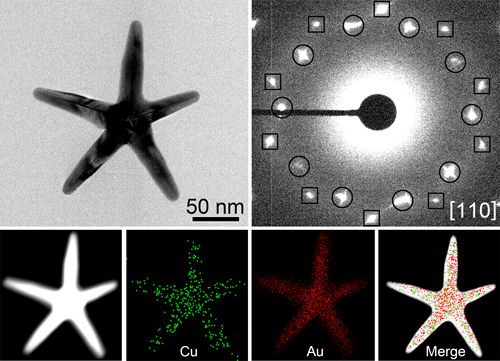Twinkle twinkle little star, how I wonder what you are…
Now this nursery rhyme met up with the inspiration of the research group of Prof. ZENG Jie from Hefei National Laboratory for Physical Sciences at Microscale and School of Chemistry and Materials Science at University of Science and Technology of China (USTC). The researchers rationally designed a novel type of star-shaped nanomaterial, which are endowed with both desirable optical and catalytic properties. The work has been published on Nature Commun. (5:4327 DOI: 10.1038/ncomms5327) with the title of “Facile synthesis of pentacle gold-copper alloy nanocrystals and their plasmonic and catalytic properties”. The co-first authors of this paper are graduate student Rong He (from USTC), undergraduate student Youcheng Wang (from USTC), and post-doctoral scientist Xiaoyong Wang (from Xiamen University).

Fig. 1. Pentacle Au-Cu alloy nanocrystals.
The star-shaped naomaterial is actually composed of uniformly distributed Au and Cu, and is highly branched with fivefold twinning. This material, pentacle Au-Cu alloy nanocrystals, could have strong plasmonic resonance in the near-infrared (NIR) region and thus the merit of photo-thermal conversion. Through the injection of pentacle nanocrystals into breast tumor-bearing mice and irradiating the tumors locally with NIR laser, researchers were able to achieve highly efficient photothermal treatment. The experimental group of mice were rid of tumor 4 days post treatment. In addition, owing to the presence of plentiful edges and unique high-index feature on branches, pentacle nanocrystals exhibited remarkable activity for the reduction of p-nitrophenol into p-aminophenol by NaBH4. Analysis of the reaction kinetics reveals that, as their size were reduced down to 70 nm, pentacle nanocrystals become even more active than 5-nm conventional citrate-coated Au nanoparticles with identical catalyst mass. This novel type of star-shaped material is promising to be applied to biomedicine and heterogeneous catalysis in the near future.
This work was supported by National Key Scientific Research Projects for Young Scientists, National Natural Science Foundation of China (NSFC), and Recruitment Program of Global Experts (1000 Talent Plan).
Open access to the paper:
http://www.nature.com/ncomms/2014/140707/ncomms5327/full/ncomms5327.html
(Hefei National Laboratory for Physical Sciences at Microscale, School of Chemistry and Materials Science)